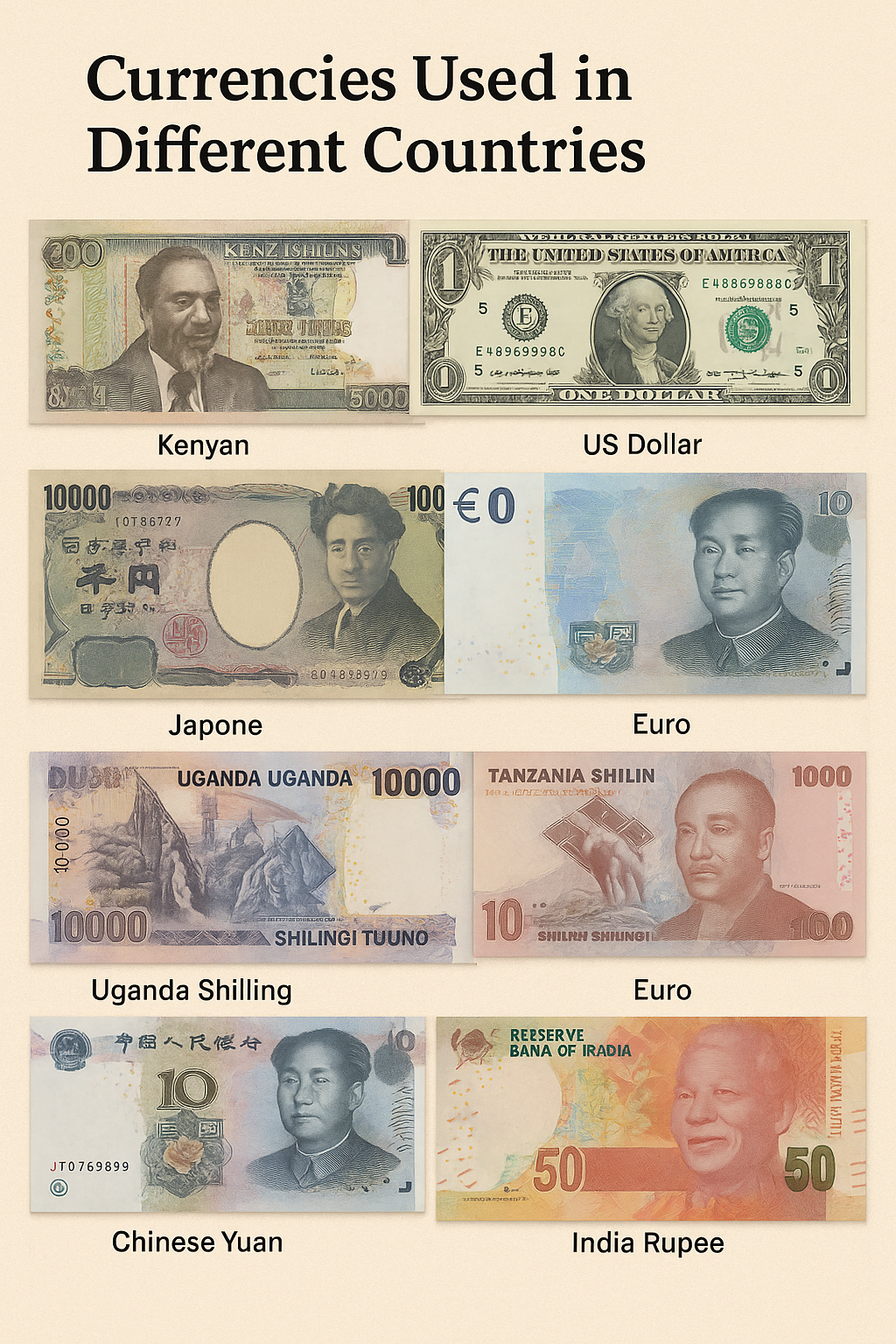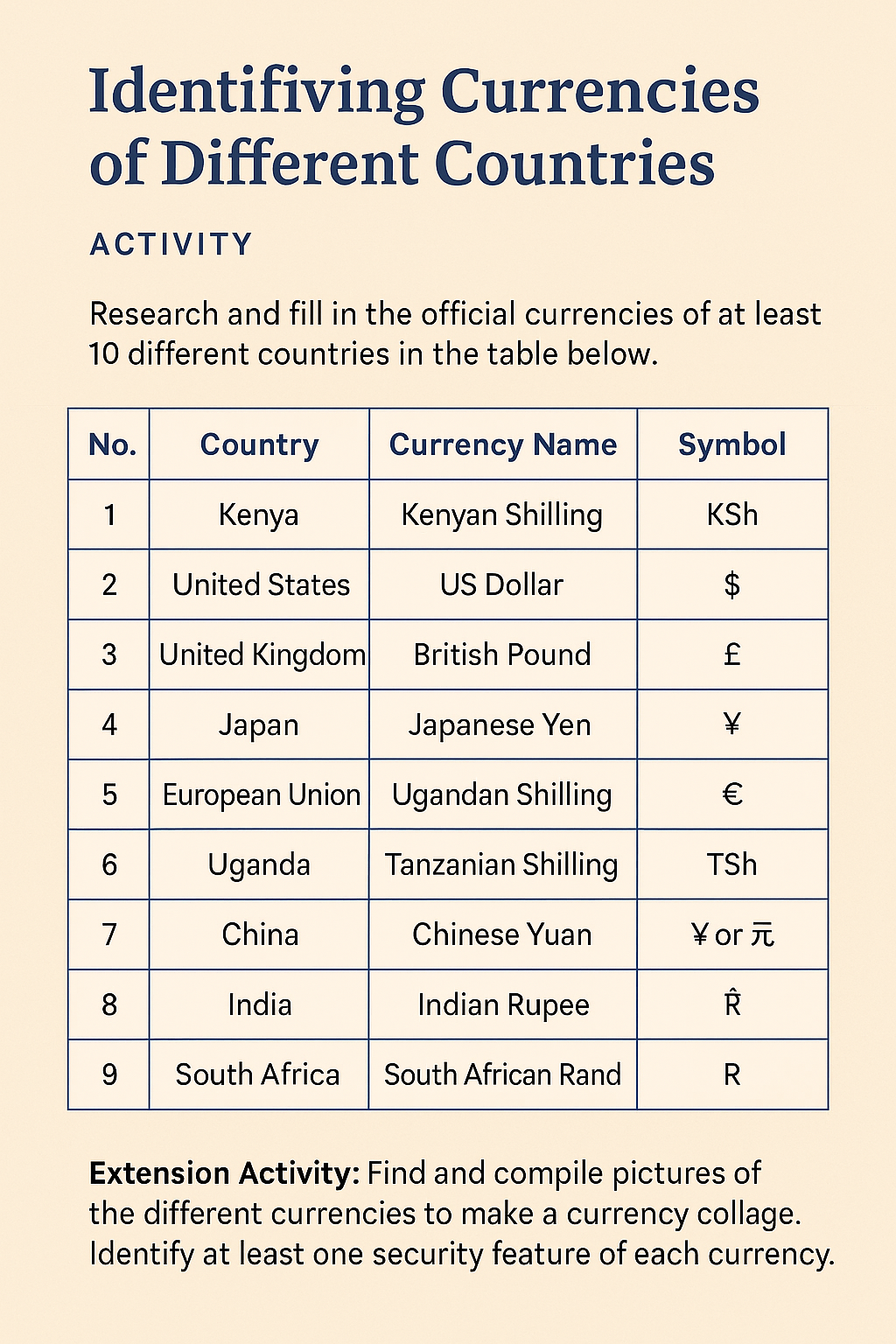Activity 3.5.1.
In this activity, you will learn about the various currencies used in different countries around the world. Understanding global currencies is essential for international travel, online shopping, and global finance.
Materials needed: Use textbooks, internet resources, or currency charts to find the official currencies of at least 10 different countries.
Objective: By the end of this activity, you will be able to identify the official currency of various countries, understand their symbols, and recognize their significance in global trade and economics.
1. Research and Collect Images of Currencies.
Internet Search: Use search engines like Google Images or Bing Images.
Search for East African Countries like:
-
Kenyan Shilling notes
-
Ugandan Shilling notes
-
Tanzanian Shilling notes
-
Somali Shilling notes
-
Rwanandan Franc notes
-
Burundian Franc notes
-
South Sudanese Pound notes
-
Ethiopian Birr notes
-
Eritrean Nakfa notes
Main Currencies we have in East Africa are:
Shilling (Kenya, Uganda, Tanzania, Somalia)
Franc (Rwanda, Burundi)
Pound (South Sudan)
Birr (Ethiopia)
Nakfa (Eritrea)
Other Global Currencies include:
Euro (EUR) - European Union
US Dollar (USD) - United States
British Pound (GBP) - United Kingdom
Japanese Yen (JPY) - Japan
Chinese Yuan (CNY) - China
Indian Rupee (INR) - India
south African Rand (ZAR) - South Africa
Canadian Dollar (CAD) - Canada
Australian Dollar (AUD) - Australia
Swiss Franc (CHF) - Switzerland
Brazilian Real (BRL) - Brazil
Russian Ruble (RUB) - Russia
Mexican Peso (MXN) - Mexico etc...
Image Sources:
Websites of Central Banks (e.g., Central Bank of Kenya)
Educational websites on world currencies
Wikimedia Commons (royalty-free images)
2. Download or Save the Images
Right-click on the currency images and select “Save image as…” to save them to your computer or device.
Name the files clearly, e.g., Kenya Shilling.jpg, Euro.jpg, etc.
3. Create the Collage

Use free online collage makers or graphic design tools such as:
-
Canva (https://www.canva.com/)
-
Fotor (https://www.fotor.com/)
-
Adobe Express (https://express.adobe.com/)
-
Microsoft PowerPoint or Google Slides (if you want to arrange manually)
\(\textbf{Collage Creation}\)
Open the collage maker or design tool of your choice.
-
Upload the saved currency images.
-
Arrange them in a creative layout.
-
Add titles or labels to show the country and currency name.
4. Save or Export the Collage
Export the collage as JPEG or PDF.
You can print it or share it digitally.
Research Task:
-
Research and list the official currency of each country.
-
Identify the symbol and code for each currency (e.g., USD for US Dollar, EUR for Euro).
-
Discuss the significance of each currency in its respective country
5. Create a Table of Currencies

| No. | Country | Currency Name | Symbol |
| 1. | Kenya | Kenya Shilling | Ksh |
| 2. | Tanzania | Tanzanian Shilling | Symbol |
| 3. | Uganda | Ugandan Shilling | UGX |
| 4. | Japan | Japanese Yen | ¥ |
| 5. | European Union | Euro | € |
| 6. | United States | US Dollar | $ |
| 7. | United Kingdom | British Pound | £ |
| 8. | South Africa | South African Rand | R |
| 9. | China | Chinese Yuan | ¥ or 元 |
| 10. | India | Indian Rupee | ₹ |
